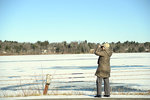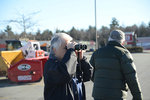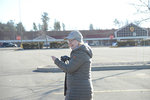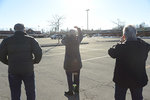 Narrowsburg
NarrowsburgLight Rain Fog/Mist, 43°
Wind: 8.1 mph
 Narrowsburg
NarrowsburgMONTICELLO, NY — I had never been birdwatching before. I was up early the Thursday after Christmas preparing for anything. I envisioned trekking through snow and mud, battling frigid …
Stay informed about your community and support local independent journalism.
Subscribe to The River Reporter today. click here
This item is available in full to subscribers.
Please log in to continue |





 MONTICELLO, NY — I had never been birdwatching before. I was up early the Thursday after Christmas preparing for anything.
MONTICELLO, NY — I had never been birdwatching before. I was up early the Thursday after Christmas preparing for anything.
I envisioned trekking through snow and mud, battling frigid temperatures, finding a secluded hideout deep in the woods and waiting patiently to spot the native birds of Sullivan County that had not flown south for the winter.
This image in mind, I packed boots, long socks, thick denim jeans, my warmest gloves, a ski jacket and two different hats. As I drove from Honesdale to Monticello, I wondered if I had brought enough.
I met a four-person team of “birders” in a Dunkin Donuts parking lot. Our team leader Ruth McKeon said, “I think we’ll start by counting the seagulls in the ShopRite Plaza.” I thought she was joking.
She wasn’t, and I realized I may have overpacked.
McKeon and her crew were part of Audubon societies around the country taking part in Christmas bird counts around this time of year to contribute to the 119th consecutive Christmas Bird Count hosted by the National Audubon Society—a census on the bird population across the Americas. The results are helpful in tracking population trends and making decisions about future conservation efforts. Last year, 76,987 birders across North America, Latin America, the Pacific Islands and the Caribbean tallied more than 59 million birds.
The Sullivan County Audubon Society (SCAC) has been taking part in the count for the last six decades, sending out teams to scour the county in its entirety. Each team sticks to a specific sector. Each bird gets counted, whether they are perched atop evergreens or telephone poles.
“We’ve been out in all kinds of weather for these counts,” Kate Hyden told me as we set off for the ShopRite Plaza in a two-car caravan. McKeon led, with Ruth Shursky in the passenger seat recording how many birds they saw. I rode with Kate and her husband Charles in the caboose.
The Hydens were hopeful to see some evening grosbeaks, which teams didn’t see last year, but that many had reported seeing in recent weeks.
Although it was a clear-weather day, it wasn’t a particularly good one for birdwatching. With no cloud cover, the sunlight was overbearing, making it hard to scan the skyline. Even more problematic, it was below freezing most of the day, which meant fewer bugs and fewer birds out hunting.
I learned that successful birdwatching is all about knowing where to go when the birds are not out in the open. In “our slice of the pie” as Kate referred to it, the best strategy was to find streams, open bodies of water, parking lots and houses with bird feeders.
Kate and Charles talked casually as we drove through the streets of Monticello at an average speed of 10 miles per hour. The topic never strayed far from that of birds, and their eyes never stopped scanning.
They told me about their fascination with nature and its inhabitants. Their home in Livingston Manor sounds like a wildlife sanctuary where many creatures, winged and four-legged, come for meals provided by the Hydens. The chickadee, the bird that appears in SCAS’s logo, is a favorite of Charles. Kate is partial to the beautiful cardinal and the gritty blue jay.
“Blue jays are like the mafia of the bird world,” Kate said.
“Thugs!” Charles added.
Every few minutes the conversation was abruptly interrupted with an interjection—“Got something, straight above us!”
I’ve always thought of birdwatching as a tranquil pastime, but it can get pretty competitive. Later this year, SCAC will host the “Break-a-hundred” competition, during which local birders try to find the highest number of species within a 24-hour  period.
period.
“Blue jays are like the mafia of the bird world."
Birdwatching is also a scientific endeavor. Birds are often harbingers of seasonal phases, and perform a similar function in alerting scientists to the impacts of climate change. The National Audubon Society published a comprehensive report in 2015, using data from sources including the Christmas Bird Count, on the effects that a changing climate has had on birds across North America. According to the report, 314—more than half—of the birds studied are climate endangered or threatened.
The birders I traveled with tried to come up with reasons for the disturbing trend we witnessed that Thursday: few birds in sight. We drove slowly through several neighborhoods, passing homes with feeders empty of food. Do people think that there are no birds around in winter? Is feed too expensive? Are people just lazy?
All throughout our day, “The Sibley Guide to Birds,” any good birder’s bible, sat in the backseat, though it was left unopened. With a quick glance, any of the team members could identify a tufted titmouse, brown creeper, or junco without a moment’s hesitation. Hungry birds are probably the only demographic that hates finding empty feeders more than passionate bird-counters.
The several dry spells we endured were broken up by some exciting finds, however. Kate’s innate raptor-radar performed well, spotting both a bald eagle and an immature red-tailed hawk, far off in the distance.
I tried to help when I could, at one point calling out—and exposing myself as a novice—that “a flock of something” had just flown into a tree behind us. But by the time we pulled over, it was too late. The tree was empty.
Our team finished the day on the low end, counting 187 birds, a result of the difficult conditions and various obstacles the day had offered. Nobody across all six groups spotted an evening grosbeak.
“That always happens,” Kate said, lamenting the fact that the more exotic birds fly around in plain view all year until it comes time to count them officially.
As they drove me back to my car, I asked if there were any final thoughts I should leave readers with, perhaps about how to help out local birds. After a moment of reflection, I got my answer,
“Tell them to keep their dang feeders full.”
Comments
No comments on this item Please log in to comment by clicking here